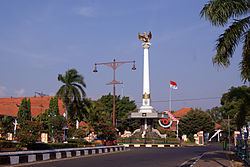Elevation 768 m (2,520 ft) Website www.jeparakab.go.id | Regency Kota Jepara Time zone WIB (UTC+7) Area 167.7 km² | |
 | ||
Weather 27°C, Wind S at 6 km/h, 87% Humidity | ||
Suzuki jimny 4x4 in jepara town
Jepara is town in the province of Central Java, Indonesia. Jepara is on the north coast of Java, north-east of Semarang, not far from Mount Muria. It is also the main town of the district of Jepara, which has a population of about 1 million. Jepara is known for the Javanese teak wood carving art as well as the birthplace of Kartini, a pioneer in the area of women's rights for Indonesians.
Contents
- Suzuki jimny 4x4 in jepara town
- Indonesian antique french country furniture distressed manufacture in jepara
- Demographics
- Economy
- History
- Contemporary Jepara
- Kingdoms
- References
Indonesian antique french country furniture distressed manufacture in jepara
Demographics
The population is almost entirely Javanese and over 98% Muslim.
The village of Plajan and The village of Tempur has a multi-religious population.
Economy
Jepara is known for its furniture industry, notably the teak furniture. The industry employs approximately 80,000 people, working in a large number of mainly small workshops. The trade has brought considerable prosperity to Jepara, well above the average for Central Java. Since there is a large export trade, the fall in the value of the rupiah against the U.S. dollar and other currencies has probably led to an increase in income for the [furniture makers].
History
People believed to have come from South Yunnan region migrated into the northern tip of Java during a time when Jepara was still separated by the Juwana Strait.
In the 16th century, Jepara was an important port; in early 1513, its king, Yunnus (Pati Unus) led an attack against Portuguese Malacca. His force is said to have been made up of one hundred ships and 5000 men from Jepara and Palembang but was defeated. Between 1518 and 1521 he apparently ruled over Demak. The rule of Ratu ('Queen') Kalinyamat in the latter 16th century was, however, Jepara's most influential. Jepara again attacked Malacca in 1551 this time with Johor but was defeated, and in 1574 besieged Malacca for three months.
It was the site of an English Fort in the 17th century. It is the birthplace of Indonesian national heroine Kartini.
Contemporary Jepara
The population is almost entirely Javanese and over 95% Muslim. As a pesisir ('coastal') area many traders from around the world landed in Jepara centuries ago. As a result, some of Jepara's resident have at part European, Chinese, Arabs, Malay or Bugis ancestry.
The town is renowned its furniture industry. The production of teak furniture, employs approximately 80,000 people in the town, working in a large number of mainly small workshops. The trade has brought considerable prosperity to Jepara, well above the average for Central Java.
